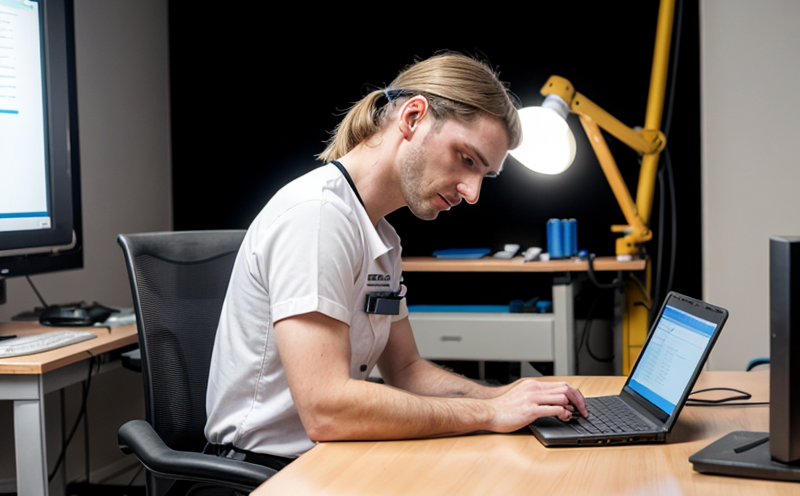SAE ARP 1874 Human Engineering Design Criteria Testing
The SAE ARP 1874 standard is a critical guideline for designing human engineering components in aerospace and aviation products. This standard ensures that all human-machine interfaces are ergonomic, safe, and user-friendly, thereby enhancing the overall safety and efficiency of aircraft operations.
Developed by the Society of Automotive Engineers (SAE), this standard focuses on ensuring that every part of a human-machine interface meets specific design criteria to prevent errors and improve situational awareness. This is particularly important in aviation where even minor design flaws can lead to significant operational inefficiencies or safety risks.
The testing process involves several key steps, starting with the identification of all interfaces between humans and machines within an aircraft system. These could include cockpit controls, displays, seating arrangements, communication equipment, and more. Each interface is then evaluated against a set of criteria outlined in the ARP 1874 standard to ensure they meet ergonomic and usability requirements.
The testing process typically includes the following steps:
- Identification of human-machine interfaces
- Evaluation against SAE ARP 1874 criteria
- Data collection using validated instruments
- Analysis of collected data to identify discrepancies or non-compliance
- Correction and re-evaluation until compliance is achieved
The standard covers a wide range of aspects, including but not limited to, visibility, reachability, controllability, and comfort. Compliance with this standard is essential for manufacturers aiming to ensure their products meet the highest safety and usability standards.
By adhering to SAE ARP 1874, companies can enhance product reliability and reduce the risk of human error in critical systems. This not only improves operational efficiency but also contributes significantly to overall aviation safety. The standard is widely recognized as a benchmark for ergonomic design in aerospace products.
Why It Matters
The importance of SAE ARP 1874 cannot be overstated, especially considering the high stakes involved in aviation and aerospace industries. Non-compliance with this standard can lead to significant operational inefficiencies, increased maintenance costs, and most importantly, safety hazards.
Compliance with this standard ensures that all human-machine interfaces are designed with ergonomic principles in mind, reducing the likelihood of errors caused by poor design. This is particularly crucial given the high level of precision required in aviation operations. Ergonomically sound designs can significantly enhance situational awareness and decision-making capabilities among pilots and other flight personnel.
Moreover, adherence to SAE ARP 1874 helps manufacturers meet regulatory requirements set forth by various aviation authorities worldwide. This ensures that products are not only safe but also legally compliant, which is essential for international operations. By meeting these standards, companies can avoid costly delays in certification processes and potential legal issues.
The standard's emphasis on usability and comfort is also reflected in its contribution to the overall user experience of flight personnel. Improved ergonomics lead to better performance and reduced fatigue among pilots and other crew members, ultimately enhancing operational efficiency and safety.
Why Choose This Test
- Comprehensive Compliance: Ensure full compliance with the latest SAE ARP 1874 standards to meet regulatory requirements.
- Ergonomic Design: Validate that all human-machine interfaces are designed ergonomically, enhancing user comfort and reducing error rates.
- Safety Assurance: Minimize risks associated with poor design by verifying compliance through rigorous testing.
- Lifetime Reliability: Identify potential issues early in the design process to ensure long-term reliability of products.
The SAE ARP 1874 Human Engineering Design Criteria Testing is a crucial step in the development and certification of aerospace and aviation products. It ensures that every product meets the highest standards for ergonomic design, safety, and usability. This testing helps manufacturers produce reliable, safe, and user-friendly products that comply with international standards.
Use Cases and Application Examples
The SAE ARP 1874 standard is widely applicable across various aerospace and aviation systems, including but not limited to cockpit controls, displays, seating arrangements, communication equipment, and more. Here are some specific examples of how this testing can be applied:
| Use Case | Description |
|---|---|
| Cockpit Controls | Testing ensures that all controls are easily accessible and intuitive, reducing the risk of pilot error. |
| Display Systems | Evaluating the visibility and readability of displays to ensure they meet ergonomic standards for pilots. |
| Pilot Seats | Testing the comfort and adjustability of pilot seats to enhance situational awareness during flights. |
| Communication Equipment | Ensuring that communication devices are ergonomically designed, facilitating clear and effective communication between crew members. |
The testing process for each use case involves a series of evaluations using validated instruments. These could include anthropometric measurements to ensure proper fit, usability tests to assess ease of operation, and ergonomic assessments to evaluate comfort levels.
- Cockpit Controls: Testing the placement and accessibility of controls to ensure they are within reach for pilots without compromising safety.
- Display Systems: Evaluating the clarity and readability of displays under various lighting conditions.
- Pilot Seats: Assessing seat adjustability, lumbar support, and overall comfort levels during extended flights.
- Communication Equipment: Ensuring that communication devices are ergonomically designed to facilitate clear and effective communication between crew members.
The acceptance criteria for each use case are defined in the SAE ARP 1874 standard. Compliance is determined by comparing test results against these criteria, with any non-compliance leading to corrective actions until full compliance is achieved.





